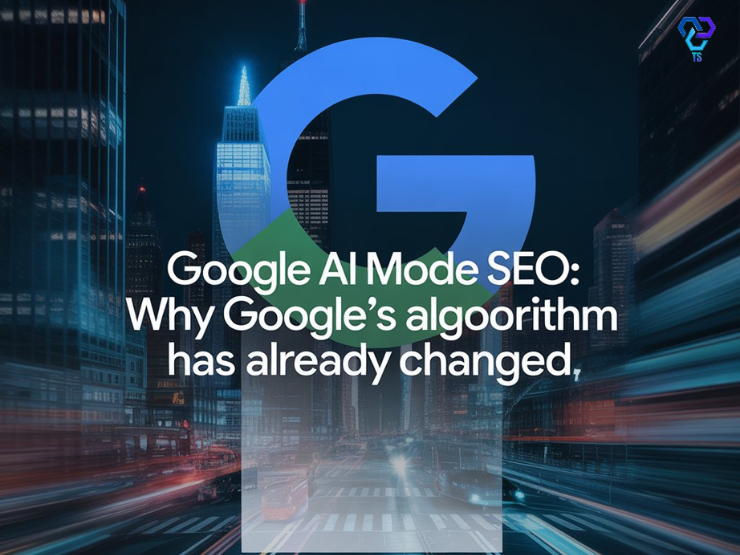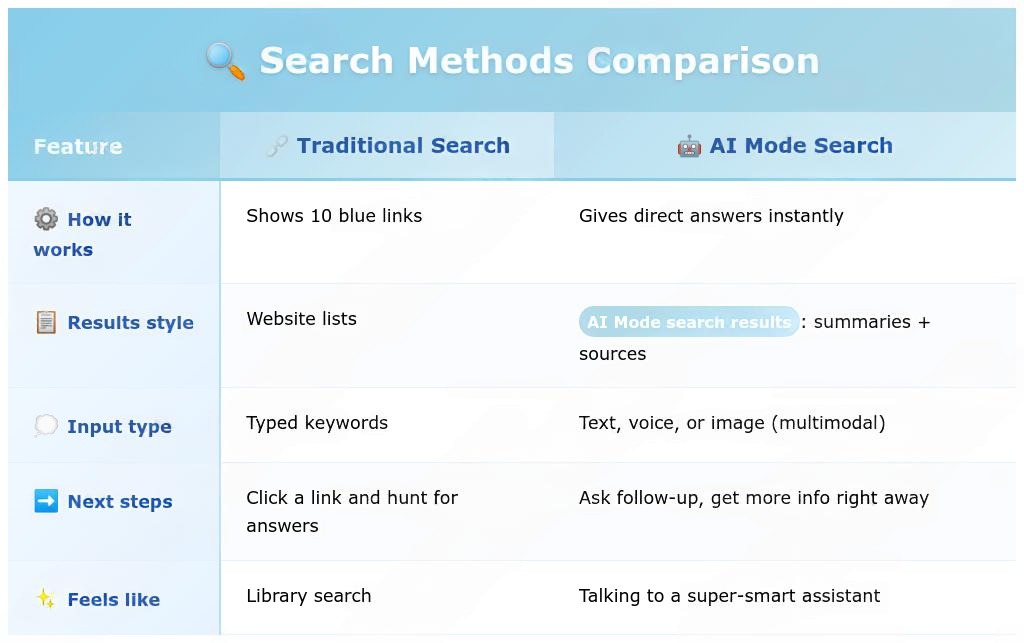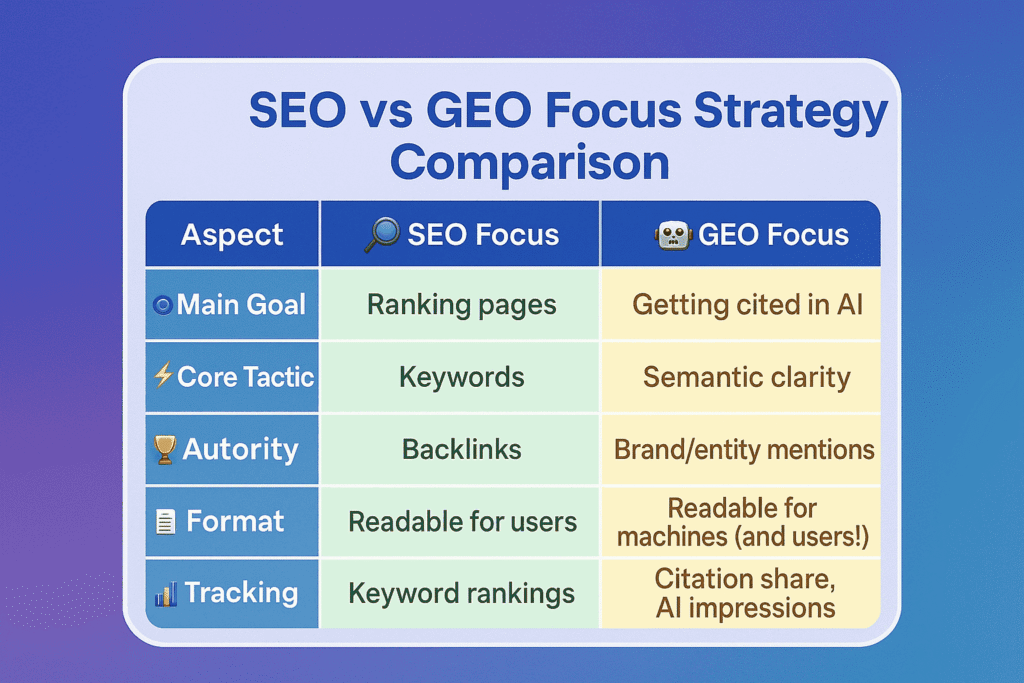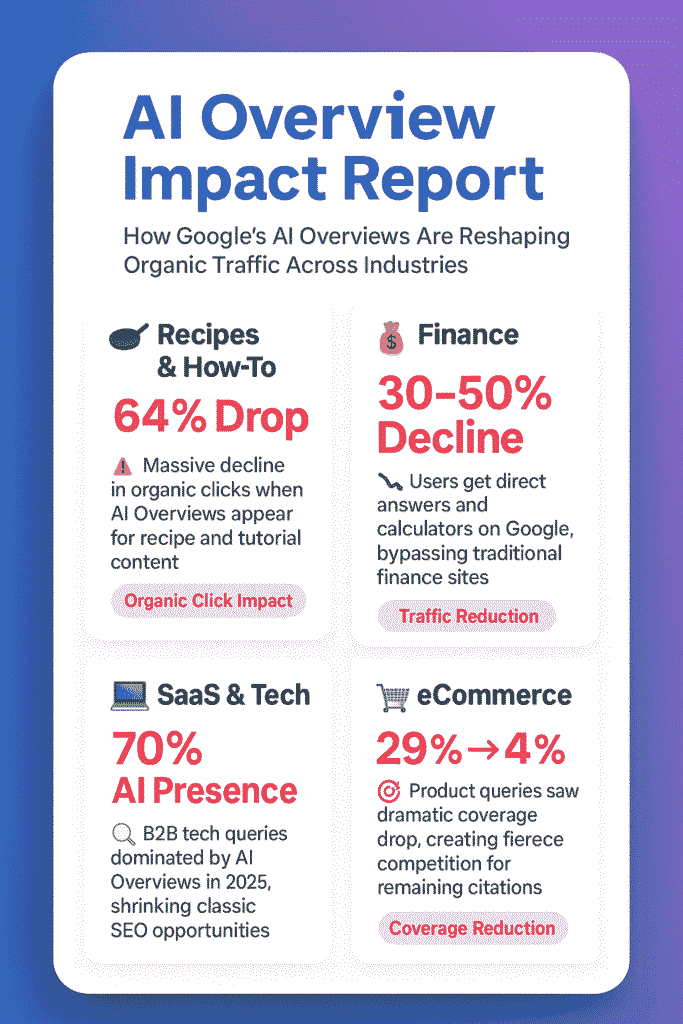
You’re preparing for a future that already arrived.
Most people don’t know it yet, but Google’s algorithm has already changed in a massive way. The old rules of SEO, the ones about keywords and blue links just aren’t enough anymore. Now, Google AI Mode SEO is running the show.
Google’s new AI Mode doesn’t just show ten links. It understands your question, explodes it into sub-questions, and gives a direct answer, sometimes without anyone ever clicking your site.
In 2024, zero-click searches hit nearly ~58.5% in the US and almost ~60% on mobile.
For many industries, this means up to a 15–64% drop in organic traffic when AI Overviews appear. If you’re still chasing old-school rankings, you’re already behind.
This is a matter because AI-powered SEO and the rise of generative AI search aren’t just trends—they’re the new normal. If you want to stay visible, trusted, and competitive, you have to adapt your strategy to how Google AI Mode actually works.
The timeline: how we got from classic search to today’s AI-powered SERP
The tech: how Google’s algorithm change in 2025 works under the hood (think Gemini 2.5, AI Mode ranking factors, and the magic of query fan-out)
The strategy: how to win visibility, brand trust, and real results in the world of LLM-powered search
By the end, you’ll know exactly what’s changed, why it matters, and what you need to do step by step.
Let’s get started.
Understanding Google’s AI Mode
Imagine if Google could talk to you like a smart friend one who answers your questions right away instead of handing you a long list of links. That’s what Google AI Mode SEO is all about.
Instead of just ranking pages by keywords, AI-powered SEO uses a brain called Gemini 2.5. This is Google’s most advanced AI system yet. It reads your question, understands your real intent, and instantly pulls the best information from all over the internet.
Powered by Gemini 2.5:
Gemini 2.5 is more than just fast it’s clever.
It breaks big questions into small pieces using called query fan-out.
For example, if you search for “Best CRM for SaaS startups,” AI Mode quietly runs 10, 15, or even more mini-searches at once (pricing, reviews, features, support, etc.) to build the perfect answer for you.
It then picks out the best chunks from many websites and shows them right in the answer, with citation hooks little links back to the original sources.

Breaks your query apart into smaller questions (even ones you didn’t ask)
Instead of only guessing from keywords, AI Mode:
Finds answers for each piece
Chooses “chunks” of info from multiple sites sometimes even from sources outside the top 100 rankings
Shows citations as links, so you can check the original source
Key AI Mode Features
Summarization → Citation Hooks: You get a short summary, and every fact has a clickable link.
Follow-ups → Passage-Level Targeting: Ask a new question, and Google’s AI fetches just the passage you need.
Interactive overlays: See charts, tables, even product comparisons, all right on the search page.
Classic blue links? They’re still there but sometimes way down the page.
User Experience Transformation
With AI Mode SERP, you don’t just search. You have a conversation.
You can ask questions, talk back, even use your voice or a photo.
Zero click search AI means people often get what they want without ever leaving Google.
Google’s AI Mode isn’t just an update it’s a total shift from search engine to answer engine.
To keep up, you need to think not just about ranking, but about being cited, quoted, and trusted by AI itself.
The Fundamental Algorithmic Shift
For years, everyone chased the #1 spot on Google. It felt like a race up a ladder if you were at the top, you got the traffic.
Now, with Google AI Mode SEO, that’s changed. Google’s AI doesn’t just pick pages. It picks sentences, paragraphs, even small facts from anywhere on the web even from sites you’ve never heard of. This is called citation-based visibility.
In fact, here’s the jaw-dropper:
43.5% of AI citations come from outside the top 100 and 56.5% come from the top 100 (with a heavy skew toward the top 10) That means being “page one” is no longer enough sometimes, it doesn’t even matter!
What Does This Mean for You?
Traditional keyword rank tracking is now misleading. You might rank #3, but if the AI Mode SERP gives the answer at the top, no one scrolls down.
Click-through rates (CTR) are dropping, but your content might still be shown (as a citation or source link) in the AI answer box so your “impression share” goes up.
SEO metrics need to evolve. Instead of just tracking “rankings” and “clicks,” you need to track citations, impression share, and brand visibility in AI-powered SERP features.
In short:
The game has changed.
It’s not just about where your page ranks, It’s about whether Google’s AI chooses your words to answer real people’s questions.
How Google’s Algorithm Has Evolved
Let’s take a quick journey through Google’s brain upgrades:
- Hummingbird (2013): First big step Google starts understanding meaning, not just matching keywords.
- RankBrain (2015): Uses machine learning to guess what you really mean, even if you ask in a weird way.
- BERT (2019): Teaches Google to read sentences like a human, understanding words in context.
- MUM (2021): Multitask Unified Model. Can handle text, images, even different languages. Super smart!
- Gemini (2025): The heart of Google AI Mode. Built for deep understanding, answering, and even talking back to you.
March 2025 Core Update: AI Comprehension Is King
With the March 2025 core update, Google’s priorities totally shifted.
Content quality became more important for rankings. Google’s AI now looks for pages that are easy for machines to read and understand not just loaded with links.
The Evolution of E-E-A-T in an AI World
E-E-A-T stands for Experience, Expertise, Authoritativeness, Trustworthiness. It used to be a “human” quality check. Now, it’s also AI-weighted:
AI-powered rankings look for real-world experience stories, facts, proof that a person or brand knows their stuff.
Source-level trustworthiness is everything: If your content isn’t trusted, you won’t be cited in AI answers no matter how well you wrote it.
Google’s Helpful Content System and Spam Detection AI
Google’s new Helpful Content System uses AI to spot and remove pages made just for clicks or stuffed with keywords. If your content is thin, copied, or “programmed” for SEO only, you’ll drop in rankings or disappear from citations.
Technical Upgrades Needed in the AI Era
If you want to win with AI Mode SEO, your site needs some tech upgrades:
Semantic markup: Use structured data (schema.org) so Google’s AI can easily read your content.
Structured entities: Clearly identify people, brands, products so AI knows what’s what.
Fact density: Pack real facts, data, and unique info into your pages. Google loves content that teaches, not just sells.
Google’s algorithm doesn’t just reward keywords or backlinks anymore. It rewards clear, helpful, trustworthy information that AI can easily understand and cite.
If your content is made for real people, clearly marked up, and packed with proof, you’ll thrive in the world of AI-powered SEO.
The Evolution from SEO to GEO (Generative Engine Optimization)
The old way of doing SEO was about making your page look good to Google’s human judges get the right keywords, win backlinks, climb the rankings.
But now, with AI-powered SEO and Google AI Mode, we’re in a new world: GEO, or Generative Engine Optimization.
GEO means optimizing your content so that Google’s AI not only finds it, but actually understands it, trusts it, and uses it as a source in answers. If you want to be seen, you need to help AI pick your words, not just your page.
Core Principle Comparison: SEO vs. GEO

Google’s AI-Focused Guidelines: The New Rules
Google now says:
Write unique, valuable content—for people first, but make sure AI can read it easily.
Use semantic precision: Be clear, use simple language, and make sure your meaning can’t get mixed up.
Add citation hooks: Place facts, definitions, and answers near the top of your content AI loves “snippet-sized” nuggets.
Use AI-friendly formatting:
- Short sentences
- Clear headings (H2, H3, etc.)
- Lists and tables for steps, tips, and comparisons
- Structured data (schema)
The Big Concept:
“You now optimize for what AI understands, not just what humans read.”
That means:
Every word needs to be clear no fluff, no jargon, no confusing details.
Your facts and expertise should be easy for both people and machines to find and quote.
Your brand or author name should show up as a trusted source, not just a blue link buried on page 3.
To succeed in AI Mode SEO, you need to master GEO.
Make your content clear, precise, and machine-readable so Google’s AI picks you for the answer box, not just the ranking list.
Industry Impact and Sector-Wise Data Analysis
How AI Answers Are Changing Organic Traffic
With Google AI Mode SEO and AI-powered SERP features, web traffic is being reshuffled. When Google answers more questions directly, fewer people click on websites. This is called organic traffic redistribution.
Traffic Drop by Industry
Not all industries are affected the same way. Here’s what the data shows:
Recipes & How-To: Up to 64% drop in organic clicks when AI Overviews appear
Finance: 30–50% traffic decline as users get direct answers and calculators on Google
SaaS & Tech: B2B tech saw 70% AI Overview presence in queries by 2025, meaning classic SEO clicks keep shrinking
eCommerce: Some product queries dropped from 29% to just 4% AI Overview coverage, so competition for those few citations is fierce.

Winners vs. Losers
Winners:
Sites with entity-heavy content (clear details about people, products, brands)
Expert brands real authority, credentials, and trust signals
Schema-rich sites those who use structured data and FAQs so AI can “see” and cite their answers
Losers:
Thin content pages with only a few sentences or no real value
Aggregator sites just copy-pasting lists or content from elsewhere
AI-spun blogs pages made by machines, for machines (no real expertise, no trust)
Analytics Tracking Challenges
Tracking performance is getting tricky:
Session attribution is disappearing. Traffic from AI Mode often shows up as “Direct” or “Unknown” in analytics tools.
Engagement patterns are new. People may see your answer on Google, remember your brand, and search for you later—so brand lift may go up, even if clicks go down.
Future Projections: Where Is This Headed?
If your content isn’t made for AI-powered SEO with facts, structure, and credibility you risk getting left out entirely.
The impact of Google AI Mode SEO is real, and it’s shaking up every industry.
The winners are brands who go deep, show real expertise, and make their content easy for both humans and AI to understand.
Content Optimization Strategies for AI Mode
The shift to Google AI Mode SEO has flipped the content game upside down. It’s no longer about “ranking #1” for a keyword. Now, you must engineer your content so Google’s AI chooses it citing your sentences, facts, and expertise in its answers. Let’s break down the exact strategies that get you noticed and cited in this new world.
1. Structure for Passage-Level Relevance
What is passage-level relevance?
In the past, Google ranked entire pages. Now, AI Mode “explodes” every query into smaller pieces and looks for the best chunk even if it’s buried halfway down your article.
Passage ranking LLM is the tech behind this: Google’s AI scans for the exact paragraph, list, or sentence that directly matches the user’s need.
How to optimize:
Write each section as if it could stand alone.
Use question-based headings.
Start with a direct, one-sentence answer.
Add supporting details, lists, and examples right after the answer.
Real Example:
Imagine you run a SaaS blog.
Old style: Long intro, fluff, keyword stuffing, answer at the bottom.
AI Mode style:
- Heading: “How does Google AI Mode impact SaaS website traffic?”
- First line: “B2B SaaS websites have seen up to 64% organic traffic drop after AI Overviews rolled out, as more users get answers directly on Google.”
- List: 3 bullet points on why (zero-click rates, citation from lower-ranked pages, drop in blue-link clicks).
- Table: Before/After AI Mode traffic, CTR, citation frequency.
2. Include “Citation Triggers” (Direct, Precise Claims)
What are citation triggers?
A citation trigger is a sentence (or data point) that’s so clear and factual, Google’s AI wants to quote it in an answer.
How to write them:
Lead with data, specifics, and actionable statements.
Make direct comparisons or bold claims, then back them up.
Add your brand or expert name if possible.
Example in context:
You’re writing a guide for eCommerce.
Citation trigger: “Product queries on Google have seen a drop from 29% to just 4% AI Overview appearance, making every citation more competitive.”
Power tip:
Front-load citation triggers: Place them early in sections, as Google’s AI tends to pick the clearest and closest matches first.
3. Use FAQ and How-To Schema Strategically
Why does schema matter?
Schema (structured data) is code that helps Google’s AI “see” your FAQs, steps, and definitions. When you use FAQ or How-To schema, you’re marking up your content in a language AI can process directly.
Use How-To schema for guides:
- “How to add FAQ schema to your blog”
- Step 1: Identify key questions.
- Step 2: Add answer blocks under each.
- Step 3: Use plugin or code to add schema.
Real Example:
A fitness website’s FAQ:
Question: “What is the best warm-up for beginners?”
Answer: “A 5-minute brisk walk or gentle jog, followed by dynamic stretches, is a safe warm-up for most beginners.”
Marked with FAQ schema, this answer is more likely to show up as a citation in AI Overviews or People Also Ask.
4. Front-Load Summaries and Structured Blocks
Why front-load?
Google’s AI grabs the clearest answer, as early as possible. If you bury your best content, you won’t get cited.
How to do it:
Start each page or section with a 2–3 sentence summary.
Use summary tables, bullet lists, and highlights for fast scanning.
Restate your main claim, stat, or answer up front.
Example:
Before:
Long intro about the history of SEO.
After:
“Summary:
Google’s 2025 algorithm update prioritizes content quality (+25%) over backlinks (-18%). Sites with schema-rich, passage-level content are now cited more often in AI answers, while thin content loses visibility.”
Table Example:
| Tactic | Result |
| FAQ schema | More AI citations, higher SGE presence |
| Front-loaded facts | Higher chance of “snippet” selection |
| Structured data (How-To, Q&A) | Visible in AI and voice search |
5. Track New KPIs for AI Mode SEO
Old SEO tracked “clicks” and “rankings.”
AI-powered SEO needs a new playbook.
Key new metrics:
- Citation Impressions (SGE)
- Brand Mention Rate
- Passage Click-Throughs
Example:
A SaaS brand tracks its “SGE citations per 1000 queries” and finds that even though total clicks dropped, branded search and direct signups went up because people remembered the name from the AI answer box.
6. Brand Recall > Pure Click-Through: The Zero-Click Mindset
Why mindshare matters:
With zero click search AI, most users don’t visit your website but they see your name and answers. Brand recall becomes more valuable than a click.
How to win mindshare:
- Make your brand visible in every citation trigger.
- Use a consistent brand voice and style.
- Encourage branded searches.
Example:
A nutrition site cited in Google’s AI for “best foods for energy” sees fewer clicks, but direct traffic and branded searches rise people trust and remember the brand even without clicking.
7. Advanced: Prompt-Engineered Content Blocks for Generative Retrieval
What’s “prompt-engineered content”?
It’s content written in the style and format that AI loves to pull, quote, and reuse for new questions.
How to build these blocks:
- Phrase subheadings as real user questions.
- Answer questions directly, then add context.
- Anticipate follow-ups and answer them inside your content.
Example:
A B2B SaaS site builds a knowledge base where every page starts with:
Question: “How do I improve AI visibility for SaaS features?”
Answer: “Use FAQ schema, passage-level blocks, and include citation triggers in every feature explanation.”
Google’s AI can now use these answers for dozens of related queries.
Putting It All Together: Real-World Content Flow Example
Imagine you’re writing a guide for “Best CRM Tools for Startups”:
Intro (front-loaded, bold stats):
Question-based sections:
- “What makes a CRM tool ideal for SaaS startups?”
- “Which features does Google AI Mode look for when citing CRM tools?”
Direct citation triggers:
- “HubSpot is the most-cited CRM in AI Overviews for startups, due to its robust integrations and public reviews.”
FAQ schema at the end:
- “How do I get my CRM reviewed by Google AI Mode?”
- “What schema should I use for CRM feature pages?”
Structured summary table:
| CRM Tool | AI Mode Citation Rate | Main Features |
| HubSpot | 45% | Integrations, Support |
| Zoho | 25% | Affordability, Customization |
| Salesforce | 15% | Scale, Analytics |
The AI-powered SEO world rewards content that’s structured, precise, and machine-friendly.
Focus on semantic clarity, citation triggers, and FAQ/How-To schema.
Track citation impressions and brand recall, not just clicks.
Use “prompt engineering” to make every section citation-ready.
If you build your content this way, you won’t just chase rankings you’ll earn a permanent seat at Google’s answer table.
Preparing for the AI-First Future
The age of Google AI Mode SEO is here. Getting ahead means rethinking your entire search strategy from the technical details to how you build authority, invest in content, and measure results.
Here’s your deep-dive, no-shortcuts playbook for lasting visibility, trust, and growth in the era of AI-powered SEO.
I. Immediate Action Checklist: The Foundation for AI Visibility
1. Run a Full Structured Data and Schema Audit
Why it matters:
Structured data (schema) is the “language” Google’s AI reads first. Without it, even your best content can be invisible to the answer engine.
How to do it:
Use auditing tools like Google Search Console, Screaming Frog, Sitebulb, or Schema.org’s own validator to scan all URLs.
Check for presence of FAQ, How-To, Article, Product, and Person schema.
Example:
- An eCommerce site discovers that only its blog pages use schema, but its top product pages don’t. After adding structured data, those products begin appearing in AI Overviews and rich snippets.
Fix all errors and warnings broken schema means Google ignores it.
Action:
Prioritize pages that already rank, get traffic, or drive conversions these are your fastest wins for AI Mode citation.
2. Rewrite Your Top 50 Pages for AI Mode
Why it matters:
Most organic traffic and brand impressions come from your top 10–50 pages. If these aren’t optimized for AI readability, you risk losing your “SERP billboard.”
How to do it:
Identify high-value pages using Google Analytics (top by traffic, conversions, or business impact).
For each, audit:
- Are there direct, fact-based answers high on the page? (Citation triggers)
- Does each H2/H3 begin with a clear, self-contained summary?
- Are Q&A, lists, and data tables present?
- Is schema markup (FAQ, How-To) implemented?
Example Rewrite:
- Before: “Welcome to our services page, where we offer multiple solutions…”
- After: “Our agency’s SEO solution helped SaaS clients achieve a 58% increase in AI citation impressions in 2025. Here’s how we do it…”
Action:
Assign writers, editors, and technical SEO to batch-update and upgrade these top assets.
Set a weekly goal (e.g., 10 rewrites per week).
3. Eliminate Technical Blockers
Why it matters:
If Google can’t access, crawl, or process your page, all content upgrades are wasted.
How to do it:
Ensure pages are indexable (no accidental “noindex” tags, robots.txt blocks, or canonicalization errors).
Test on mobile and for Core Web Vitals (load speed, interactivity).
Example:
- A SaaS blog fixes mobile rendering issues and jumps from “unknown” to cited in multiple SGE answer boxes.
Action:
Do a bi-annual technical SEO review even after the initial push.
II. Long-Term Strategic Planning: Build an AI-Resilient Brand
1. Build Topical Authority
Why it matters:
Google’s AI chooses “experts,” not just pages. Being the #1 authority on a subject (not just a keyword) boosts your eligibility for both rankings and citations.
How to do it:
Create pillar content:
- Identify 3–5 core topics your business should “own.”
- For each, build a comprehensive main guide (2,000+ words), then support it with deep-dive articles, FAQs, and case studies.
Example:
- An insurance brand launches a “2025 Insurance Master Hub” covering auto, home, and business insurance. Each topic hub links to expert guides, policy comparisons, and real-life claims stories.
Cross-link related articles:
Action:
Quarterly content calendar with topic-cluster planning and regular refreshes of cornerstone pages.
2. Invest in Expert-Driven Content
Why it matters:
E-E-A-T (Experience, Expertise, Authoritativeness, Trustworthiness) is now AI-graded. Real human expertise beats mass-produced content, every time.
How to do it:
Hire or feature true experts:
- Showcase author bios, certifications, professional history.
- Add direct quotes, video clips, or Q&A with known experts.
Case studies and personal stories:
- Share behind-the-scenes details and real outcomes.
Example:
- A finance blog hires a certified CPA to review all tax guides. Each post opens with “Reviewed by [Name], CPA,” and includes a byline with credentials. These pages soon show up as trusted citations in Google’s AI answers.
Action:
Budget monthly for expert contributors and content reviews.
3. Integrate AI Monitoring into SEO Operations
Why it matters:
You can’t manage what you don’t measure especially in a fast-changing AI landscape.
How to do it:
Track “citation impressions” and SGE/AI Overview mentions in Google Search Console or third-party SEO tools.
Set up dashboards to monitor:
- Top cited pages
- New keywords triggering AI Overviews
- Which content types or formats get most citations (tables, FAQs, direct answers)
Example:
- A SaaS team tracks weekly changes in their “Share of Citation” and pivots content toward the format and topics getting the most SGE visibility.
Action:
Monthly SEO ops meetings to review AI Mode performance, set new optimization goals, and brainstorm experiments.
III. Resource Allocation: Spend Where It Drives AI Visibility
1. Reduce Low-Value Content Output
Why it matters:
Thin, low-value, or generic content isn’t just ignored it can harm your overall authority in Google’s eyes, reducing your chance of AI citation everywhere.
How to do it:
Audit for “zombie content”:
- Use analytics to find pages with near-zero visits or engagement.
- Delete, merge, or upgrade these pages—don’t keep “dead weight.”
Stop mass-producing short posts just to hit a quota.
Example:
A tech site cut its publishing volume by 70%, reinvesting in fewer, much deeper guides. Within 6 months, its SGE citations triple even as traffic fell.
2. Reinvest in Content Depth, Entity Modeling, and Brand Trust
How to do it:
Content depth:
- Go beyond basics. Include unique data, graphics, expert insights, and case studies.
- “10x” your most valuable guides every quarter.
Entity modeling:
- Use schema to mark up people, products, organizations, locations, and key concepts.
- Add glossaries, definition boxes, and entity cards inside articles.
Brand trust:
- Promote reviews, media mentions, awards, and “as seen in” banners.
- Build partnerships and get mentioned/cited by other trusted sites.
Example:
An eCommerce brand mapped all their products and categories as schema entities. Their product comparison tables started being cited in Google’s AI summaries for “best running shoes 2025.”
IV. Timeline Example: Month-by-Month Transformation
Month 1: Audit & Priority Fixes
Complete sitewide schema and technical audit.
Identify and upgrade top 50 traffic/conversion pages.
Prune or merge low-value posts.
Months 2–3: Content Overhaul
Publish/refresh pillar guides and topic clusters.
Launch new FAQ and How-To schema sitewide.
Add case studies, data tables, and expert-driven content.
Months 4–6: Testing, Optimization, and Growth
Monitor AI Overview and SGE citations weekly.
Expand and tweak pages with rising citation impressions.
Conduct A/B testing on headlines, summaries, schema types.
Case Example:
A legal advisory site rolled out this process. By month 3, their “how-to” guides began appearing as direct answers in legal AI Overviews, and by month 6, branded search and referral sign-ups had increased 40%.
V. Success Frameworks: How to Measure Real Progress
1. Share of SERP vs Share of Citation
Track both traditional rankings and the frequency/placement of your brand, pages, and specific sentences in AI Overviews, SGE, and other answer boxes.
2. Session Quality Over Volume
Don’t panic if raw traffic drops look at dwell time, engagement, and especially “branded conversions” (sign-ups from users who searched for you by name after seeing you in an AI answer).
3. AI Recall vs Link Click
Brand recall how many users search for your brand, talk about you, or return later—is now as important as click-through.
Run regular surveys, check direct/brand query volume, and monitor social mentions for lift after SGE/AI citations.
The AI-first future is already here waiting to be met by those who act, not those who delay.
The winners will:
- Treat schema and entity modeling as must-haves
- Build authority with expert-driven, in-depth content
- Track and chase citations, not just clicks
- Invest in brand presence and recall
- Continuously audit, test, and adapt
You don’t need to outspend the competition. You need to out-trust, out-structure, and out-answer them for both people and AI.
Conclusion
TL;DR:
SEO didn’t die. It evolved.
You can’t just chase rankings and expect to win anymore.
Google AI Mode SEO means rankings ≠ visibility, being number one doesn’t matter if the AI doesn’t cite you.
Now, it’s about optimizing for influence over indexing.
Structure your content for AI, not just humans.
Focus on being clear, credible, and quote-worthy.
Track your share of citation, not just clicks or keywords.
The rules have changed.
If you want to stay visible, you must write for both Google’s users and Google’s AI.
Final thought:
In a world where Google writes the answer, you must write what it quotes.
